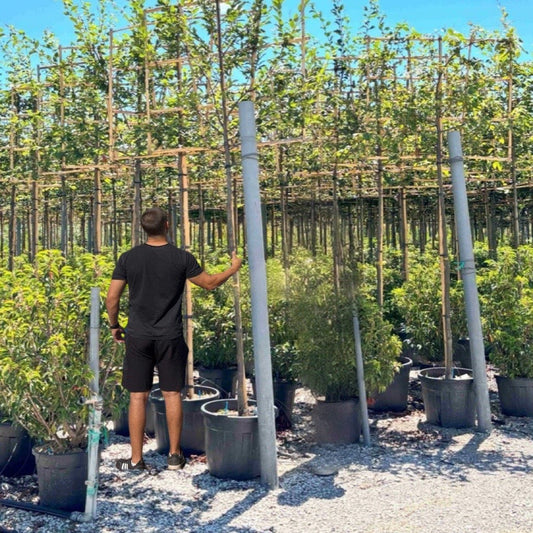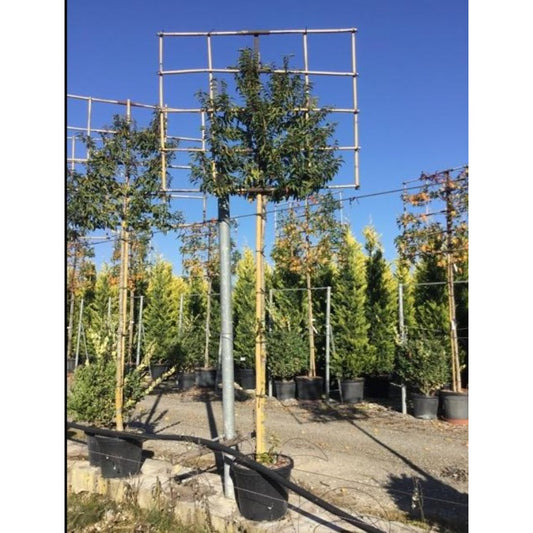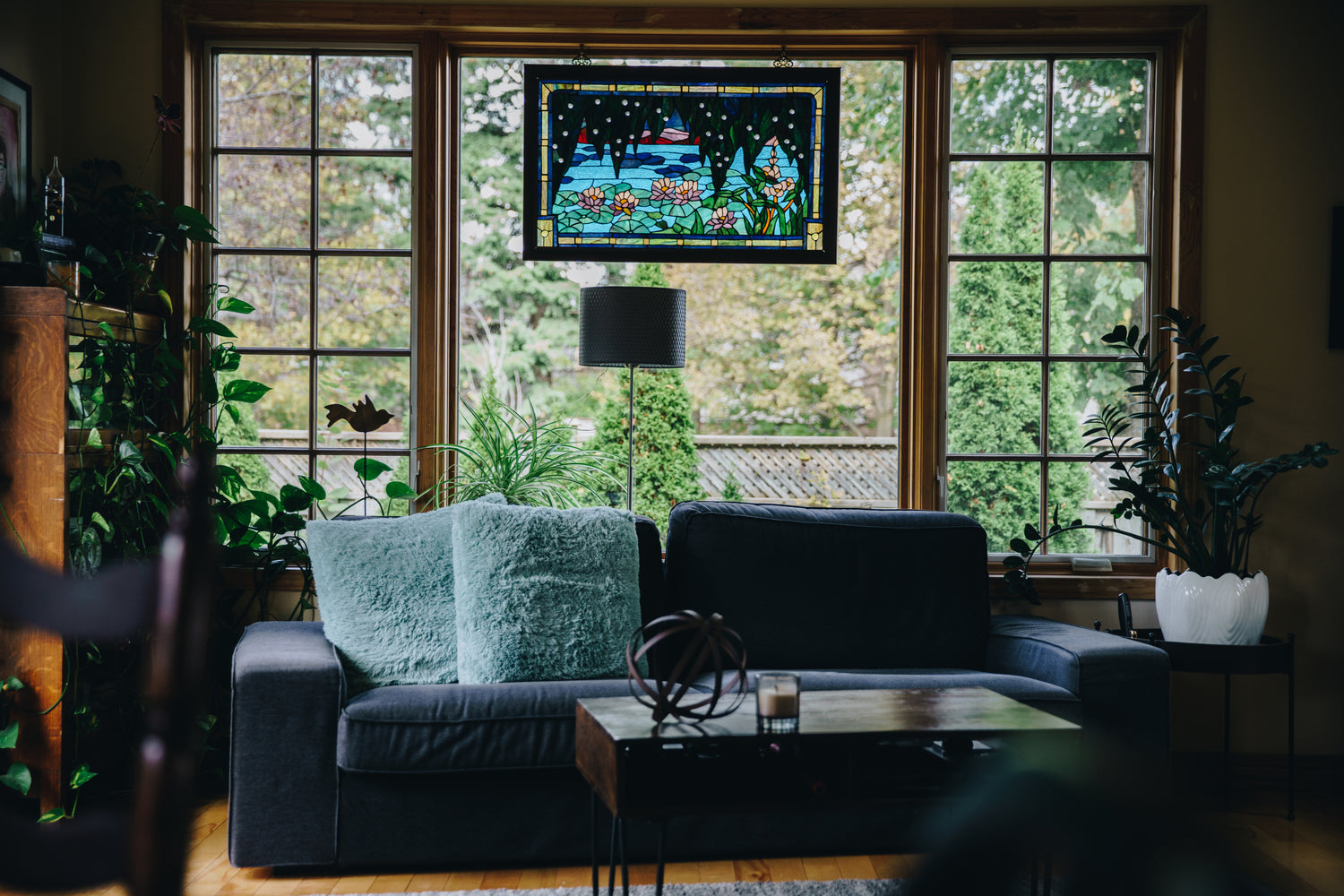Pleached trees are a unique and highly decorative form of tree training that creates a refined, structured appearance in a garden or landscape. By definition, pleaching is a horticultural technique in which trees are trained to grow with long, straight trunks and a canopy that has been meticulously shaped and trimmed into a flat, hedge-like form, often on a framework of stakes or wires. This creates the effect of a "hedge on stilts," providing a distinct look that blends the height of a tree with the density and formality of a hedge.
The technique of pleaching has a long history, dating back to ancient times, and was particularly popular in formal European gardens. Pleached trees were used to line walkways, create garden rooms, or even form living walls and arches. Today, pleached trees continue to be a favored choice for adding architectural interest, privacy, and elegance to both traditional and contemporary landscapes.
How Are Pleached Trees Created?
The process of pleaching involves several key steps:
- Selecting the Right Trees: Not all trees are suitable for pleaching. Trees with flexible branches and a propensity for dense foliage are ideal. Common species include hornbeam, beech, and various evergreens like photinia.
- Training the Canopy: Young trees are planted and their branches are pruned and tied to a horizontal framework or trellis. As the trees grow, the branches are regularly trimmed and guided along the framework to ensure they develop in the desired shape.
- Maintaining the Form: Once established, the pleached trees require regular maintenance to keep their shape. This typically involves trimming once or twice a year, usually in late winter or early summer, to remove unwanted growth and keep the canopy dense and even.
Benefits of Pleached Trees
Pleached trees offer several advantages over traditional tree planting, making them a popular choice for landscape architects and gardeners alike:
- Low Maintenance: Despite their elegant appearance, pleached trees are surprisingly easy to care for. Their compact, structured form means they require minimal pruning beyond the regular trimming to maintain their shape.
- Space Efficiency: Due to their narrow profile, pleached trees are ideal for smaller gardens or urban settings where space is at a premium. They provide height and structure without encroaching too much on the ground space, allowing for other plants or features beneath them.
- Privacy and Screening: One of the most popular uses of pleached trees is for privacy. Their tall, dense canopies can create effective screens against neighbors or busy roads, offering a green, living alternative to fences or walls. They can also be used as windbreaks, reducing wind speed and protecting other plants in the garden.
- Aesthetic Appeal: Pleached trees add a formal, architectural element to the landscape. They can be used to frame views, line paths, or create a sense of enclosure in a garden. Their sculpted appearance adds elegance and structure, making them a standout feature in any setting.
How to Choose the Right Pleached Tree for Your Property
Choosing the right pleached tree involves considering several factors:
- Purpose: Determine what you want the pleached trees to achieve. If you’re looking for privacy, a taller, denser species like cherry laurel or evergreen holm oak might be best. For purely decorative purposes, lighter, more airy species like hornbeam or sweet gum can provide the desired effect.
- Size and Scale: Pleached trees come in a range of sizes, from small specimens suitable for hedging to large trees that create dramatic screens. Measure your planting area and consider the height and spread of the trees when fully grown to ensure they fit comfortably within your space.
- Soil and Climate Considerations: Most pleached trees prefer well-draining soil and a sunny location. However, it’s important to choose species that are suited to your local climate. Some species are more tolerant of wind, shade, or different soil types, so be sure to match the tree’s needs with your garden’s conditions.
- Maintenance Requirements: While pleached trees are generally low maintenance, some species require more frequent trimming or are more susceptible to pests and diseases. Understanding the care needs of different species will help you select a tree that fits your gardening style and time commitment.
Planting Pleached Trees
Planting pleached trees requires careful preparation to ensure they establish well and grow successfully:
- Location: Choose a sunny spot with good drainage. Pleached trees do not thrive in waterlogged soil, so avoid low areas where water might collect.
- Planting Hole: Dig a hole that is twice the size of the tree’s root ball or pot. Mix the excavated soil with compost or well-rotted manure to improve soil fertility and structure.
- Positioning: Place the tree in the hole, ensuring it is at the same depth as it was in the pot. Backfill with the enriched soil, firming it gently around the roots to eliminate air pockets. Water thoroughly to settle the soil.
- Staking and Support: Depending on the size of the tree and the exposure of the site, you may need to provide additional staking or support to keep the tree stable, especially while it establishes.
Caring for Pleached Trees
Once planted, pleached trees are relatively low maintenance, but a few steps will help them thrive:
- Watering: Young pleached trees need regular watering, particularly during dry spells. Aim to keep the soil consistently moist but not waterlogged. Mature trees are more drought-tolerant but should still be watered during extended dry periods.
- Fertilization: An annual application of a balanced fertilizer during the growing season will provide the necessary nutrients for healthy growth. Avoid over-fertilizing, as this can lead to excessive, weak growth that may be difficult to maintain.
- Pruning: Regular trimming is essential to maintain the shape and density of the pleached canopy. Use sharp, clean shears to remove any wayward branches and to trim the canopy back to the desired shape. The best time to prune is in late winter or early summer, before the trees put on their main flush of growth.
- Pest and Disease Management: Keep an eye out for common pests such as aphids, caterpillars, and scale insects, as well as fungal diseases like powdery mildew. Prompt treatment with appropriate pest control or fungicides can help keep your trees healthy.
Popular Types of Pleached Trees
Pleached trees come in a variety of species, each offering different aesthetics and functional benefits:
-
Evergreen Species:
- Pleached Photinia Red Robin (Photinia x fraseri): Known for its striking red new growth, this evergreen provides year-round interest and dense foliage.
- Pleached Cherry Laurel (Prunus laurocerasus Novita): A robust, fast-growing evergreen with glossy green leaves, perfect for privacy screens.
- Pleached Holm Oak (Quercus ilex): A tough, evergreen oak with small, leathery leaves, ideal for coastal areas or exposed sites.
-
Deciduous Species:
- Pleached Hornbeam (Carpinus betulus): A classic choice with neatly serrated leaves that turn golden in the autumn, retaining some foliage through winter for partial screening.
- Pleached Liquidambar Sweet Gum (Liquidambar styraciflua): Known for its spectacular autumn color, this deciduous tree adds seasonal interest with its star-shaped leaves.
Expert Advice and Selection
Choosing the right pleached tree for your garden can be a complex decision, but many nurseries offer expert advice and a wide selection of high-quality UK-grown pleached plants. Whether you are looking for a specific species or need guidance on which trees will best suit your needs, consulting with an expert can ensure you make the best choice for your landscape.
Conclusion
Pleached trees offer a sophisticated, versatile, and low-maintenance solution for enhancing privacy, adding structure, and creating stunning visual effects in gardens of all sizes. With careful selection, proper planting, and minimal maintenance, pleached trees can provide a beautiful and long-lasting addition to your outdoor space, delivering both functional benefits and aesthetic appeal for years to come.










